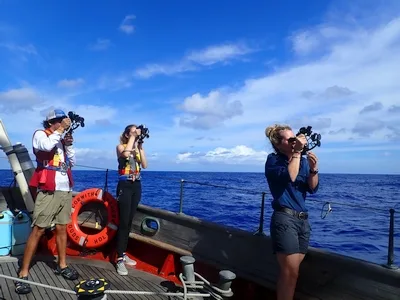News
Star Frenzy!

Ship’s Log
Position
22º 40.4’ N x 057º 12.1’ W
Ship Heading
250º
Ship Speed
4 knots
Taffrail Log
2437 nm
Weather / Wind
Clear and sunny, northeasterly winds at 8 knots
Description of location
Southern Sargasso Sea, nearing the Tropic of Cancer
Among the many things that we students are learning to do aboard the SSV Corwith Cramer, one of my favorite things that I have learned so far is the art of celestial navigation. Although it is not a requirement to learn how to shoot and plot celestial fixes, it is something I have personally found a lot of joy and pleasure in doing.
Celestial navigation is how we are navigating the ship through the Atlantic to get to the Virgin Islands and I want to give all of you a peak into what it is that some of us are doing.
 Brier, Colin, me: Cel nav nerds debating if what we’re looking at is Altair or Vega
Brier, Colin, me: Cel nav nerds debating if what we’re looking at is Altair or Vega
While we are navigating by the sun, moon and stars, we are also plotting dead reckoning positions to follow the celestial fixes. Dead reckoning positions are assumed position based on time, distance and ship heading. This does not account for wind and current so in order to keep us on our cruise track we pull out our sextants and shoot celestial fixes throughout the day. We try to shoot sun sights and Local Apparent Noon (LAN) every day so that we can keep track of our position beyond dead reckoning during the hours in which we cannot shoot the stars.
Twice a day we have something called star frenzy which, during the nautical dawn twilight and during the evening civil twilight. During star frenzy we grab our sextants and aim to shoot 6 stars. We try to shoot at least one star from three quadrants in the sky as well as one low star, one mid and one high in order to get a total of 6 altitudes on the arc (but the more the merrier).
 Me shooting Kochab during evening star frenzy.
Me shooting Kochab during evening star frenzy.
The position at the beginning of the blog post is actually one that I calculated using the stars and planets this evening (Jupiter, Saturn, Vega, Altair, Deneb, Schedar, Fomalhaut). I have to say, did not have much knowledge of stars and constellations before this trip and I certainly to did not expect to get as involved as I have with celestial navigation, but it is now something that is part of my regular routine. I am very thankful to Captain Allison and 2nd Mate Colin for teaching me celestial navigation and helping me enhance my skills. Because of them I’ve found a new hobby and passion for celestial navigation.
– Taylor Hunt, C Watch and Coastal Carolina University
P.S. To my family and friends, blow a tender kiss to Saturn and it will bounce off of the rings like a ricochet biscuit and I’ll catch it with my sextant. I miss you all very much and I will talk to you soon!
P.P.S. Shout out to Anna’s mom and brother who have had recent birthdays. Happy birthday to both of you!
P.P.P.S. Shoutout to my boy LAN nomsayin… course yardy know.
(Written November, 3, 2021)